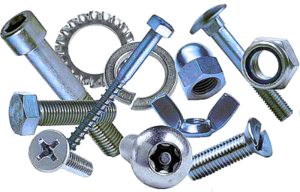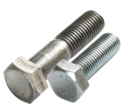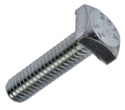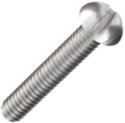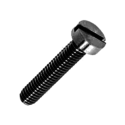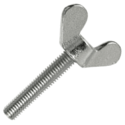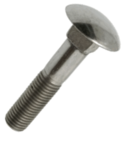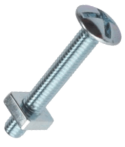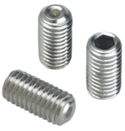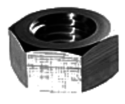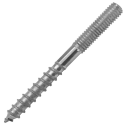Nuts, Bolts and Washers: Difference between revisions
From DT Online
mNo edit summary |
(Added text and images) |
||
| Line 18: | Line 18: | ||
{| | {| | ||
|- | |- | ||
| '''Hexagonal''' | | [https://en.wikipedia.org/wiki/List_of_screw_drives#Hex '''Hexagonal''' ] | ||
| | | These six-sided headed bolts and screws are now the most common in general use. Most '''[[Spanners]]''' and '''[[Sockets]]''' are designed to work with '''Hexagonal Nuts and Bolts''' | ||
| [[File:###| | | [[File:HexHdBoltScrew.png|125px|right]] | ||
|- | |||
| [https://en.wikipedia.org/wiki/List_of_screw_drives#Square '''Square'''] | |||
| These were more common before modern manufacturing techniques made hexagonal bolts and screws cost effective and hence preferred. They are still available and tend to be used for the more rugged applications. | |||
| [[File:SqHdScrew.png|125px|right]] | |||
|- | |||
| '''Round''' | |||
| Round head machine screws provide a smooth finish less likely to snag loose clothing for example. Originally, all screws of all types had [https://en.wikipedia.org/wiki/List_of_screw_drives#Slot '''Slot Heads'''] for use with a standard flat bladed '''[[Screwdriver]]''' but [https://en.wikipedia.org/wiki/List_of_screw_drives#Phillips '''Phillips'''] and [https://en.wikipedia.org/wiki/List_of_screw_drives#Pozidriv '''Pozidrive'''] type heads are now more common together with [https://en.wikipedia.org/wiki/List_of_screw_drives#Hex_socket '''Socket Head'''] types and various [https://en.wikipedia.org/wiki/List_of_screw_drives#Tamper-resistant_types '''Tamper Resistant'''] designs. | |||
| [[File:RndHdmachineScrew.png|125px|right]] | |||
|- | |||
| '''Cheese Head''' | |||
| Machine Screws with a cylindrical head of height approximately half the head diameter. They are a traditional screw used in precision work and, like [https://en.wikipedia.org/wiki/Screw#Hex_cap_screws '''Cap Screws'''], they can be sunk below the surface of the material in a [https://en.wikipedia.org/wiki/Counterbore '''Counterbored'''] hole. | |||
| [[File:CheeseHdScrew.png|125px|right]] | |||
|- | |||
| [https://en.wikipedia.org/wiki/Screw#Screw_head_shapes '''Countersunk''' ] | |||
| Abbreviated to Csk.Hd., these bolts and screws have a cone shaped head which allow them to sit within a [https://en.wikipedia.org/wiki/Countersink '''Countersunk'''] hole such that they can finish flush with the surface of the material. | |||
| [[File:CskHdMachineScrew.png|125px|right]] | |||
|- | |- | ||
|''' | |'''Wing Bolts''' | ||
| B | | B | ||
| [[File: | | [[File:WingBolt.png|125px|right]] | ||
|- | |- | ||
| ''' | | [https://en.wikipedia.org/wiki/Carriage_bolt '''Coach Bolts''' ''(aka Carriage Bolts)'' ] | ||
| B | | B | ||
| [[File: | | [[File:CoachBolt.png|125px|right]] | ||
|- | |- | ||
| ''' | | [https://en.wikipedia.org/wiki/Carriage_bolt '''Roofing Bolts'''] | ||
| B | | B | ||
| [[File: | | [[File:RoofingNutBolt.png|125px|right]] | ||
|} | |} | ||
| Line 38: | Line 54: | ||
{| | {| | ||
|- | |- | ||
| [https://en.wikipedia.org/wiki/Hex_key '''Allen Screws'''] | | [https://en.wikipedia.org/wiki/Screw#Hex_cap_screws '''Socket Head Cap Screws'''] | ||
| Commonly referred to a [https://en.wikipedia.org/wiki/Hex_key '''Allen Screws'''], these precision cap screws are similar to '''Cheese Head Screws''' and used for similar purposes but they are often made from [https://en.wikipedia.org/wiki/Carbon_steel '''High Tensile Steel (H.T.S.)'''] and use a [https://en.wikipedia.org/wiki/Hex_key '''Allen Key'''] to tighten them. | |||
| [[File: | | [[File:CapScrew.png|125px|right]] | ||
|} | |} | ||
| Line 47: | Line 63: | ||
|- | |- | ||
| [https://en.wikipedia.org/wiki/Set_screw '''Grub Screws'''] ''(aka Set Screws)'' | | [https://en.wikipedia.org/wiki/Set_screw '''Grub Screws'''] ''(aka Set Screws)'' | ||
| | | These headless screws are commonly used for holding components in place on rotating shafts for example. Originally with a '''Slot Head''' for use with a flat blade '''[[Screwdriver]]''', the '''Socket Head''' or '''Allen Screw''' versions are now preferred | ||
| [[File: | | [[File:GrubScrew.png|125px|right]] | ||
|} | |} | ||
| Line 55: | Line 71: | ||
|- | |- | ||
| '''Hexagonal''' | | '''Hexagonal''' | ||
| | | Their six-sided shape allows spanners and wrenches to be used with them in relatively confined spaces. | ||
| [[File: | | [[File:HexNut.png|125px|right]] | ||
|- | |- | ||
|'''Square''' | |'''Square''' | ||
| B | | B | ||
| [[File:###| | | [[File:###|125px|right]] | ||
|- | |- | ||
| '''Locking Nut''' | | '''Locking Nut''' | ||
| B | | B | ||
| [[File:###| | | [[File:###|125px|right]] | ||
|- | |- | ||
| '''Wing Nut''' | | [https://en.wikipedia.org/wiki/Wingnut_%28hardware%29 '''Wing Nut'''] | ||
| B | | B | ||
| [[File: | | [[File:WingNut.png|125px|right]] | ||
|} | |} | ||
| Line 76: | Line 92: | ||
| '''Plain''' | | '''Plain''' | ||
| B | | B | ||
| [[File:###| | | [[File:###|125px|right]]| | ||
|- | |- | ||
|'''Spring''' | |'''Spring''' | ||
| B | | B | ||
| [[File:###| | | [[File:###|125px|right]] | ||
|- | |- | ||
| '''Repair''' | | '''Repair''' | ||
| B | | B | ||
| [[File:###| | | [[File:###|125px|right]] | ||
|- | |- | ||
| '''Spring''' | | '''Spring''' | ||
| B | | B | ||
| [[File:###| | | [[File:###|125px|right]] | ||
|} | |} | ||
| Line 95: | Line 111: | ||
|- | |- | ||
| [https://en.wikipedia.org/wiki/Threaded_rod '''Studs'''] | | [https://en.wikipedia.org/wiki/Threaded_rod '''Studs'''] | ||
| | | These can be made from '''Threaded Rod''' or purpose made - sometimes with a different thread at each end ''(a coarse thread at one end for entry into a material coupled with a fine thread at the other end for greater vibration resistance). | ||
| [[File: | | [[File:Stud.png|125px|right]] | ||
|- | |||
| [https://en.wikipedia.org/wiki/Threaded_rod '''Screw Stud'''] | |||
| Variously known as '''Hanger Screws''' or '''Dowel Screws''', these studs have a screw thread at one end and a wood screw at the other to faciliate the task of joining wood to components of various materials. | |||
| [[File:WoodScrewStud.png|125px|right]] | |||
|} | |} | ||
Revision as of 13:32, 19 August 2015
Nuts and Bolts are available in a wide variety of sizes, types of screw thread, shapes of head and materials to provide a very commonly used means of fastening components together such that they can be removed if needed.
A screw thread is one of the Basic Machines comprising a small thread cross-section wrapped around a cylinder as a Helix - which in itself can be simulated by wrapping a triangle around a cylinder. It follows that coarser threads have bigger thread cross sections and are therefore stronger, especially in softer materials, but fine threads follow the Helix traced by a more Acute angled triangle and grip tighter because they are a thinner Wedge or Inclined Plane - (e.g. the cylinder head Studs of a high revving engine may have fine threads at the top to resist vibration but coarse threads where they screw into the soft aluminium crankcase).
Machine Screws are very similar to Bolts except that, in general, Bolts have a plain section of shank below the head whereas Machine Screws are threaded right up to the head.
Sizes are now most commonly standardised in terms of their diameter in millimetres (e.g. a 10mm bolt has an external diameter of 10mm) although British Association (B.A.) threads may still occasionally be found in the smaller sizes of screws. Older, now largely obsolete, standards include British Standard Whitworth (i.e. B.S.W.; B.S.F.; B.S.C. and B.S.B.), British Standard Pipe (or B.S.P. in which the size number was originally based on the inner diameter of a steel tube for which the external thread was intended), and the American Unified Thread Standard (i.e. U.N.C. and U.N.F.) - which are still in use in USA and Canada although there is movement towards the increasingly universal ISO Metric standard.
Bolt and Screw Head Shapes
| Hexagonal | These six-sided headed bolts and screws are now the most common in general use. Most Spanners and Sockets are designed to work with Hexagonal Nuts and Bolts | |
| Square | These were more common before modern manufacturing techniques made hexagonal bolts and screws cost effective and hence preferred. They are still available and tend to be used for the more rugged applications. | |
| Round | Round head machine screws provide a smooth finish less likely to snag loose clothing for example. Originally, all screws of all types had Slot Heads for use with a standard flat bladed Screwdriver but Phillips and Pozidrive type heads are now more common together with Socket Head types and various Tamper Resistant designs. | |
| Cheese Head | Machine Screws with a cylindrical head of height approximately half the head diameter. They are a traditional screw used in precision work and, like Cap Screws, they can be sunk below the surface of the material in a Counterbored hole. | |
| Countersunk | Abbreviated to Csk.Hd., these bolts and screws have a cone shaped head which allow them to sit within a Countersunk hole such that they can finish flush with the surface of the material. | |
| Wing Bolts | B | |
| Coach Bolts (aka Carriage Bolts) | B | |
| Roofing Bolts | B |
Cap Screws
| Socket Head Cap Screws | Commonly referred to a Allen Screws, these precision cap screws are similar to Cheese Head Screws and used for similar purposes but they are often made from High Tensile Steel (H.T.S.) and use a Allen Key to tighten them. |
Grub Screws
| Grub Screws (aka Set Screws) | These headless screws are commonly used for holding components in place on rotating shafts for example. Originally with a Slot Head for use with a flat blade Screwdriver, the Socket Head or Allen Screw versions are now preferred |
Types of Nut
| Hexagonal | Their six-sided shape allows spanners and wrenches to be used with them in relatively confined spaces. | |
| Square | B | [[File:###|125px|right]] |
| Locking Nut | B | [[File:###|125px|right]] |
| Wing Nut | B |
Washers
| Plain | B | [[File:###|125px|right]]| |
| Spring | B | [[File:###|125px|right]] |
| Repair | B | [[File:###|125px|right]] |
| Spring | B | [[File:###|125px|right]] |
Studs
| Studs | These can be made from Threaded Rod or purpose made - sometimes with a different thread at each end (a coarse thread at one end for entry into a material coupled with a fine thread at the other end for greater vibration resistance). | |
| Screw Stud | Variously known as Hanger Screws or Dowel Screws, these studs have a screw thread at one end and a wood screw at the other to faciliate the task of joining wood to components of various materials. |
